
Hermitage
East Bay Street
Nassau, Bahamas
top
Built by Lord Dunmore as a summer residence between 1787 and 1796, the original Hermitage stood on property extending from the West boundary of Stanley, east to Dick's Point.
The house was subsequently purchased by a Mr. Whylly who sold the house to a Mr. Dames. It was later owned by a Mr. T. Darling and in the 1880's by an English lady, a Miss Stuart. It was purchased in 1932 by His Eminence Cardinal William O'Connel, Archbishop of Boston, who bequeathed it to the Catholic Diocese of Nassau. It is now the residence of the Roman Catholic Bishop of Nassau.
The mansion, the greater part of which was built between 1918 and 1922, comprises a large drawing room, a dining room, six bed rooms and three bathrooms. Connected with the main house is a servants house of Bermuda stone comprising the kitchen and store rooms. The whole house is a combination of Bermuda stone, cement and native hardwood.

The Priory
(Dunmore House)
West Street
Nassau, Bahamas
Dunmore House was built by Lord Dunmore between 1787 and 1788. It was rented as a residence for Governors until the present Government House was completed in 1804. In 1829 Dunmore House was purchased by the War Department and converted into Officers Quarters and Mess Hall. The House was subsequently converted into a military hospital. In 1893 the house was purchased from the War Department by the Roman Catholic Church and converted into a priory. It is now the future home of the National Museum of the Bahamas.

Christ Church Cathedral
George Street, off Bay Street
Nassau, Bahamas
top
The foundation stone of the present Christ Church was laid by Governor Sir Francis Cockburn in 1837, occupying the site of four smaller churches.
In 1670, the Bahamas was granted to six of the Lord Proprietors of Carolina by King Charles II and a church was soon built on New Providence. This church, the first in the Bahamas, is now Christ Church. The first church was destroyed by the Spaniards in 1684 and a second one rebuilt in 1695 by Governor Trott. This was also destroyed by the Spaniards in the joint French and Spanish invasion of 1703. A third church of wood began in 1721 under Woodes Rodgers, first Royal Governor, the frame being imported from Carolina. The fourth church made of stone was completed between 1753 and 1754; a steeple was added in 1774 but removed in 1827. The Church tower was constructed in 1830.
The present church, consecrated in 1845 by Bishop Spenser was enlarged between 1864-1865. Stained glass windows were installed in 1868 and replaced in 1945 after being damaged. In 1861 the Diocese of Nassau was created and Christ Church designated "The Cathedral Church of the Bahamas" thus making the town "the City of Nassau."

St. Matthew's Church
Shirley Street
Nassau, Bahamas
top
The foundation stone was laid in 1800 and the oldest church building in the Bahamas opened for divine service on 18 July 1802, Reverend Henry Goombridge was appointed Rector in February 1802. The steeple was erected in 1816, the clock along with the one at Christ Church was for a long time the only two reliable time-pieces on the island.
Surrounded by an extensive burial ground, this church with its early Norman style windows was designed and built by Joseph Eve with money voted by the Legislature. The total cost of the church (excepting the steeple) was £7,128.0.6.
In 1887 St. Matthew's was enlarged by the erection of a vestry room, organ chamber and new chancel which was consecrated by Bishop Churton in December of that year. The stained glass window was erected in memory of Bishop.

St. Andrew’s Presbyterian Kirk
Shirley Street
Nassau, Bahamas
top
St. Andrew's Presbyterian Kirk was the third christian congregation to be established in the Bahamas, and the Kirk is the second oldest church building on New Providence
The Kirk, the child of St. Andrew's Society of the Bahamas was founded in 1798 by fifty-five Scottish Settlers. The foundation stone of the Kirk was laid on 7 August 1810. The first Minister of the church was Reverend John Rae, M.A. The first re-modeling of the church took place in about 1822.
Many architectural changes have been made to the original church. The belfry was erected in 1844 and a spire added three years later but was destroyed in the 1866 hurricane. In 1864 the Sanctuary was enlarged and the modern transept (now the nave), portico, and bell tower were built. Extensive renovations took place in the late 1940's and early 1950's. The Kirk Hall begun in 1873 was finished and opened on 17 May 1874. In that year, Peck's Slope, named after Captain Peck, Surveyor General at that time, and which runs by the Kirk Hall, was opened.

Trinity Church
corner of Frederick Street
Nassau, Bahamas
top
Trinity Church, at the corner of Frederick Street (which was cut out of the rock in 1793) and Trinity Place, was built between 1861 - 1865 for £6,200. The hurricane of October 1866 destroyed it. It was rebuilt and reopened in 1869 and again destroyed in 1886. It was rebuilt in its original gothic style of architecture (the plan was originally drawn in England by Mr. Pocock), it was rebuilt with the present roof being about ten feet lower than the former one. The cost of the building and its re-construction cost nearly £14,000, about £4,250 being granted by the Legislature.
In 1928 it was again badly damaged by a hurricane. However the insurance claim was sufficient to construct the church as it is today. There has been no significant change to the fabric of the church. A new pipe organ was installed in 1964 and stained glass windows on the south side in June 1973.
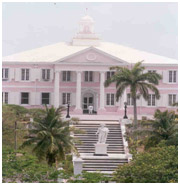
Government House
Governor's Residence
Government Hill
Nassau, Bahamas
On land known as Mount Fitzwilliam purchased from Paul Drumgold at the top of George Street, the present Government House was originally erected in 1801 during Governor Halkett's administration. The eastern wing including the ball-room was built between 1907 and 1910. It was a badly damaged building, but after the 1929 hurricane it had to be pulled down. The new building was erected and was ready to receive the Governor Sir Bede and Lady Clifford and their guests the Right Honourable Winston & Mrs. Churchill in 1932.
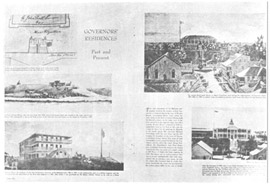
copied from Nassau Magazine Feb-March 1942 by permission of Rev. David Jennings).
The statue of Columbus was imported by Sir James Carmichael Smyth in 1830. The interior of Government House was redecorated under the Duke and Duchess of Windsor in 1940. His Royal Highness Prince Charles lived there during the Independence celebrations in 1973.
Earlier governors lived in a house situated on a ridge west of Fort Nassau and at Dunmore House, West Street.
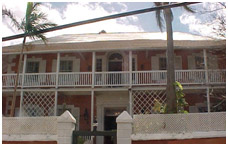
GrayCliff
West Hill Street
Nassau, Bahamas
top
Graycliff, a huge stately Georgian colonial style mansion is believed to be about one hundred and seventy-five years old. Legend has it that it served as an Officers' Mess for the West Indian Garrison. The cellars have low and thick walls and bars which may indicated that a garrison was once housed there.
It was once the home of R.H. Sawyer, C.M.G. who in 1867 proposed the disestablishment of the Church of England in a resolution to the House of Assembly. For a period it was run as a guest house by Mrs. Polly Leach and Sir Winston Churchill and his daughter Diane stayed there.
In recent years it has been owned by Dorothy J. Killiam who sold it to Lord and Lady Dudley. In 1975 it was sold to an Italian group who have converted it into a small guest house and restaurant - the house being preserved in its previous state.
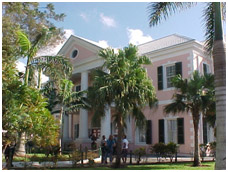
Supreme Court
Shirley & Parliament Street
Nassau, Bahamas
top
The foundation stone having been laid by His Excellency Sir Harry Cordeaux in 1920 the Supreme Court is similar in design to the central Public Building north of it and was erected in 1921 in Neo-Georgian style.
On the ground floor were the Supreme and Magistrate's Courts while the Registry, Jury Room, Chief Justice and Attorney General's Chambers and the Law Library were upstairs. Except the Magistrate's Court and Attorney General's Chamber which have been re-located, the other offices are still found in this old but beautiful and well kept building. To the south is the garden of Remembrance.
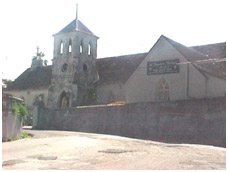
St. Francis Xavier's Catholic Church
West Hill Street
Nassau, Bahamas
top
Construction on this church began in 1885 under the supervision of Father O'Keefe the resident priest. The construction received a setback September 1, 1886 during a storm where a workman was killed by lightening and the roof, doors and walls were damaged. Nevertheless within nine weeks the building was ready for its first public mass on November 7th, 1886.
Information courtesy of St. Francis Xavier's Catholic Church




 State-Recognized Funeral Service for the Late Dr. Corolyn Hanna, former Social Activist and Nation-BuilderSee details...
State-Recognized Funeral Service for the Late Dr. Corolyn Hanna, former Social Activist and Nation-BuilderSee details... Awarded Public Procurement Opportunities ReportSee details
Awarded Public Procurement Opportunities ReportSee details











